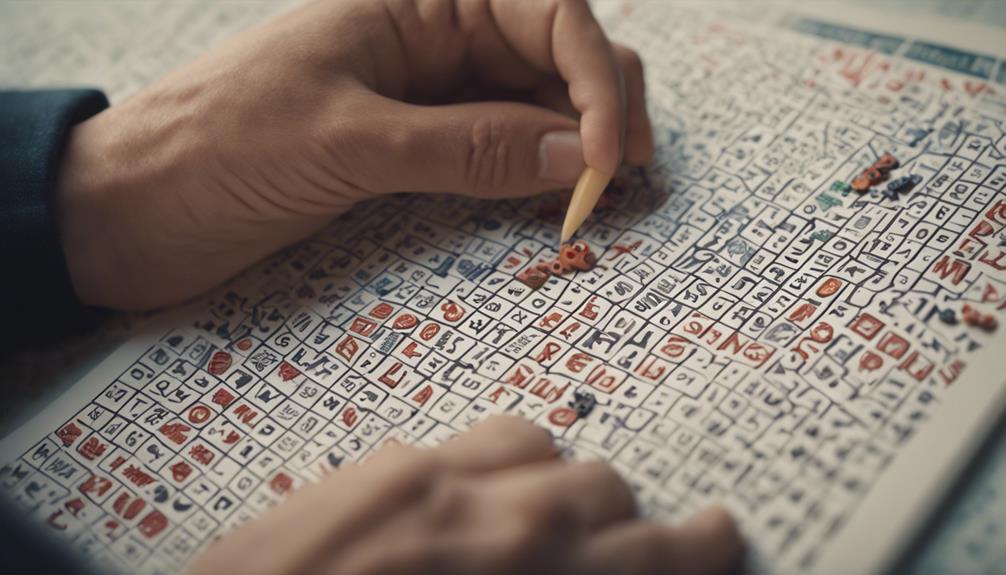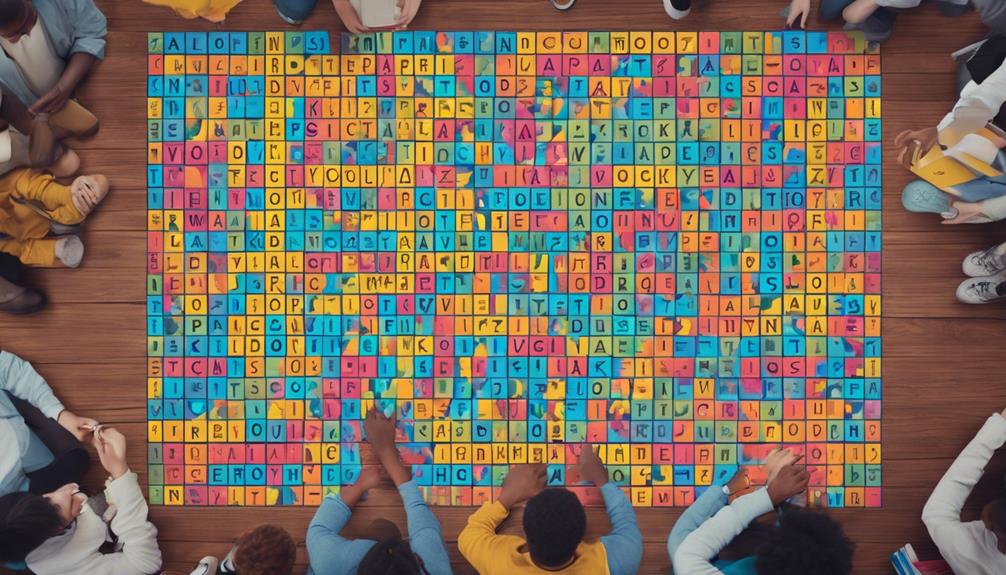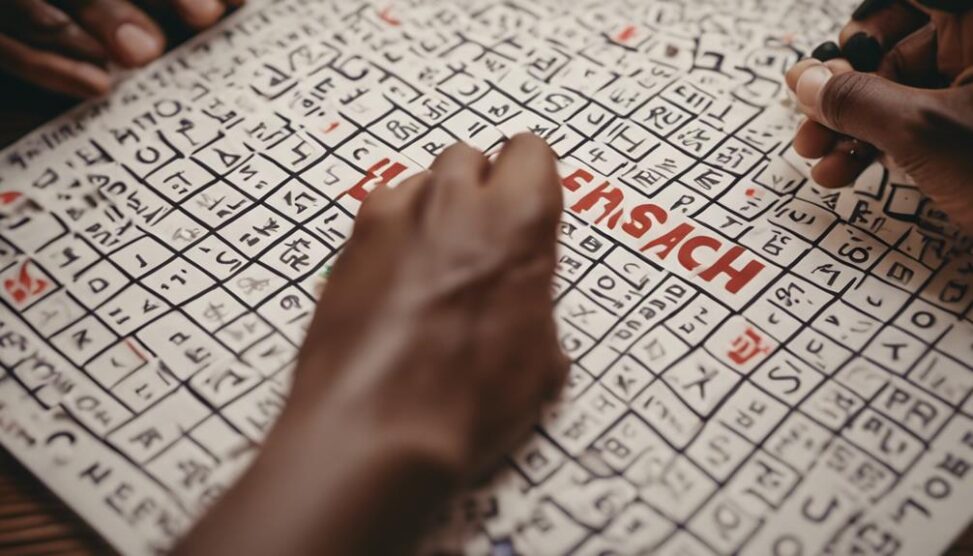When tackling cross-cultural word search puzzles, you might find yourself at the intersection of familiarity and novelty. The challenge lies in deciphering words that transcend borders and languages, offering a unique blend of cognitive stimulation and cultural exploration.
As you navigate through the intricate web of linguistic nuances and symbolic representations, you begin to unravel a tapestry of interconnected meanings that transcend mere words.
Stay tuned to discover how these puzzles not only sharpen your cognitive skills but also serve as a gateway to a world of diverse perspectives and shared experiences.
Key Takeaways
- Cultural backgrounds shape word associations and impact cognitive processes.
- Linguistic diversity and adaptability influence semantic interpretations.
- Dialectal nuances and cultural symbols enrich puzzle engagement and educational value.
- Semantic significance and psychological factors play key roles in cross-cultural word associations.
Exploring Cultural Vocabulary Challenges

Exploring the intricate challenges presented by cultural vocabulary differences is essential for effectively navigating cross-cultural communication. In a world rich with diverse linguistic nuances, understanding the cultural context behind words is crucial to bridging communication gaps.
Language barriers often arise not just from direct translation mismatches but also from the underlying cultural connotations attached to certain words or phrases. The way a word is used within a specific cultural context can significantly impact its meaning, making it vital to delve deeper into the cultural roots of vocabulary.
🌊 Discover Endless Fun with Beachcomber Press Puzzle Books! 🌊
Elevate your puzzle game with our captivating collection on Amazon.
Perfect for all ages, our books are packed with unique
challenges that promise hours of entertainment.
Understanding Writing System Variations
Understanding the variations in writing systems across different cultures is crucial for effective cross-cultural communication. When delving into the intricacies of writing systems, it becomes evident that script variation and character evolution play significant roles in shaping the way languages are visually represented. Additionally, phonetic discrepancies and linguistic evolution further contribute to the diversity seen in writing systems worldwide.
To grasp the essence of writing system variations, consider the following points:
- Script Variation: Different cultures have developed unique scripts over centuries, each with its aesthetic and functional qualities.
- Character Evolution: The evolution of characters within a writing system reflects the historical, social, and cultural changes of a society.
- Phonetic Discrepancies: Variations in phonetic representations can lead to differences in how sounds are transcribed and interpreted.
- Linguistic Evolution: Languages evolve over time, influencing the way they're written and read in a particular writing system.
Adapting to Linguistic Differences

Navigating through diverse linguistic landscapes requires adaptability and a keen awareness of cultural nuances to ensure effective communication. Language adaptation and cultural sensitivity play pivotal roles in fostering successful cross-cultural communication. When engaging with word search puzzles across different languages, linguistic adaptation becomes crucial. Being mindful of the nuances in vocabulary and syntax is key to deciphering the puzzle grids accurately.
To illustrate the importance of linguistic adaptation in cross-cultural word search puzzles, consider the following table showcasing how the word "family" is represented in three different languages:
| Language | Word | Translation |
|---|---|---|
| English | Family | – |
| Spanish | Familia | – |
| Mandarin | 家庭 | Home |
Navigating Dialectal Nuances in Puzzles
In deciphering word search puzzles, being attuned to dialectal nuances is essential for accurate interpretation and completion.
- Dialectal interpretations: Different regions may have varying terms for the same object, requiring an understanding of these linguistic differences to identify words in the puzzle accurately.
- Cultural nuances: Recognizing cultural references within the puzzle can unlock solutions that may be elusive without an appreciation for the context in which the words are embedded.
- Puzzle solutions: By navigating dialectal nuances, you can overcome linguistic challenges and uncover hidden words that align with the cultural background of the puzzle creator.
- Enhanced comprehension: Embracing dialectal diversity not only enriches your puzzle-solving experience but also broadens your perspective on language and culture.
Incorporating Cultural Symbols and Icons

Incorporating cultural symbols and icons into word search puzzles enhances the depth of engagement and fosters a deeper connection to the diverse heritage represented. By including symbolic representations and cultural icons, the puzzles become more than just a game; they become a celebration of cultural imagery and visual representation. These elements not only add complexity to the puzzles but also provide a unique opportunity for solvers to learn about different cultures in an interactive way.
| Cultural Symbols | Cultural Icons |
|---|---|
| Traditional clothing | National landmarks |
| Festive celebrations | Historical figures |
| Sacred rituals | Famous artworks |
| Indigenous patterns | Iconic foods |
Integrating these elements prompts solvers to explore and appreciate the richness of various cultures. It invites you to consider the significance behind each symbol and icon, fostering a sense of curiosity and respect for cultural diversity. By immersing yourself in these word search puzzles, you embark on a journey of discovery and appreciation for the vast tapestry of human heritage.
Overcoming Translation Obstacles in Puzzles
To ensure seamless communication and understanding across different languages, addressing translation obstacles in puzzles is paramount for a universal gaming experience. When it comes to language barriers and puzzle solutions, it's essential to navigate the complexities of multilingual gaming. Here are some key points to consider:
- Cultural Sensitivity: Acknowledge translation challenges by being mindful of cultural nuances and context when designing puzzles. This helps in creating inclusive and engaging experiences for all players.
- Localization Strategies: Implementing effective localization techniques can bridge the gap between languages and enhance players' comprehension of clues and instructions within the puzzles.
- Adapting Content: Adapting content to suit various languages and regions can aid in overcoming translation hurdles, ensuring that the essence of the puzzle is preserved across different linguistic backgrounds.
- Collaborative Approach: Encouraging collaboration among diverse language experts can lead to innovative solutions for incorporating cultural clues, enriching the puzzle-solving experience for all participants.
Embracing Multilingual Word Search Strategies

Navigating the intricacies of multilingual word search puzzles requires a keen understanding of how language nuances and cultural contexts shape the gaming experience. To excel in this domain, embracing diverse strategies and utilizing multilingual search techniques are paramount. By adapting your approach to encompass various languages and cultural references, you can enhance your puzzle-solving skills significantly.
| Multilingual Search Techniques | Embracing Diverse Strategies |
|---|---|
| Translate keywords into multiple languages | Incorporate idioms and slang terms from different cultures |
| Utilize online translation tools for assistance | Seek out word search puzzles in different languages |
| Collaborate with multilingual individuals for insights | Experiment with different search patterns based on language structures |
| Learn basic vocabulary in various languages | Consider the cultural connotations of words when searching |
Analyzing Cross-Cultural Word Association
When exploring cross-cultural word associations, it becomes evident that language intricacies and cultural nuances significantly influence the connections formed between words. Studying cross-cultural cognition reveals fascinating insights into how individuals from different backgrounds perceive and link words.
Analyzing word association patterns across cultures unveils a rich tapestry of interconnected meanings and interpretations. Here are four key points to consider:
- Cultural Influences: Cultural backgrounds mold the way individuals associate words, impacting the depth and breadth of these connections.
- Language Structures: Variations in linguistic structures affect the strength and nature of word associations, shaping cognitive processes.
- Semantic Significance: Understanding the semantic weight of words within a culture is crucial for deciphering the intricate web of associations.
- Psychological Factors: Psychological elements such as memory, experience, and perception play a pivotal role in shaping cross-cultural word associations, adding layers of complexity to the cognitive process.
Exploring these aspects illuminates the intricate dynamics of cross-cultural word associations, providing a deeper understanding of the interconnected nature of language and culture.
🌊 Discover Endless Fun with Beachcomber Press Puzzle Books! 🌊
Elevate your puzzle game with our captivating collection on Amazon.
Perfect for all ages, our books are packed with unique
challenges that promise hours of entertainment.
Enhancing Cross-Cultural Puzzle Accessibility

Enhancing accessibility to cross-cultural puzzles involves incorporating diverse linguistic and cultural elements to cater to a broader audience. By emphasizing cultural sensitivity in puzzles and adopting inclusive design in games, creators can ensure that their puzzles resonate with people from various backgrounds. This approach not only acknowledges the diversity of players but also enriches the puzzle-solving experience by offering a more inclusive and engaging gameplay.
In today's global puzzle trends, addressing language barriers is crucial for making cross-cultural puzzles more accessible. Implementing language barrier solutions such as multi-language support, translation features, or visual cues can help bridge communication gaps and enable players from different linguistic backgrounds to enjoy the puzzles equally. Embracing these inclusive practices not only fosters a sense of belonging among players but also promotes cultural appreciation and understanding through gameplay. By enhancing cross-cultural puzzle accessibility, game developers can create a more welcoming and engaging environment for puzzle enthusiasts worldwide.
Utilizing Technology for Multicultural Puzzles
To further extend the reach of cross-cultural puzzles and enhance their accessibility, integrating cutting-edge technology becomes paramount in creating multicultural puzzle experiences that captivate diverse audiences. Embracing technology integration and cultural immersion opens up a world of possibilities for creating engaging multicultural puzzles that resonate with individuals from various backgrounds.
Here are four key ways technology can revolutionize the realm of multicultural puzzle innovation and global engagement:
- Augmented Reality Experiences: By incorporating AR technology, players can immerse themselves in interactive and dynamic puzzle environments that blend elements from different cultures seamlessly.
- Online Collaboration Platforms: Utilize online platforms to connect puzzle enthusiasts worldwide, fostering a sense of community and collaboration across borders.
- AI-Powered Personalization: Leveraging artificial intelligence algorithms can help tailor puzzle experiences to individual preferences, ensuring cultural relevance and engagement.
- Mobile Applications: Developing mobile puzzle apps allows for convenient access to multicultural puzzles anytime, anywhere, promoting global engagement and inclusivity.
Addressing Educational Benefits of Diversity

How do diverse cultural perspectives in educational settings contribute to enriching learning experiences and fostering understanding among students?
Promoting inclusivity through puzzles involves incorporating words and themes from various cultures, exposing students to new languages, traditions, and ways of thinking. By engaging with cross-cultural word search puzzles, students not only expand their vocabulary but also develop empathy and respect for diverse backgrounds.
Bridging cultural divides through games like word search puzzles can break down stereotypes and encourage collaboration among students from different cultural backgrounds. As they work together to solve these puzzles, students learn to appreciate each other's perspectives and strengths, creating a more harmonious and inclusive learning environment.
Through these interactive and engaging activities, students aren't only enhancing their language and cognitive skills but also gaining valuable insights into the richness of diversity. Embracing cultural differences through puzzles fosters a sense of unity and cooperation, ultimately preparing students to thrive in an increasingly interconnected world.
Fostering Cross-Cultural Puzzle Community
Exploring the communal aspect of cross-cultural puzzles reveals the potential for fostering a vibrant and inclusive puzzle community among students of diverse backgrounds. When it comes to fostering community engagement and promoting cultural exchange through cross-cultural puzzles, consider the following:
- Shared Experiences: Engaging in cross-cultural puzzles allows individuals from different backgrounds to come together, share experiences, and build connections beyond language barriers.
- Learning Opportunities: By working on these puzzles collaboratively, participants not only enhance their puzzle-solving skills but also learn about each other's cultures, fostering a sense of appreciation and understanding.
- Empowerment Through Inclusivity: Creating a welcoming environment where everyone's perspectives are valued can empower individuals to express their cultural identities freely and contribute to a more inclusive community.
- Celebrating Diversity: Cross-cultural puzzles provide a platform to celebrate the richness of diversity, encouraging participants to explore new perspectives and embrace the beauty of varied traditions and languages.
Frequently Asked Questions
How Do Cultural Word Search Puzzles Contribute to Promoting Diversity and Inclusivity?
When you engage with cultural word search puzzles, you actively promote cultural understanding and social impact. These puzzles represent diversity, raising awareness about inclusivity. By participating, you contribute to a more inclusive and diverse society.
🌊 Discover Endless Fun with Beachcomber Press Puzzle Books! 🌊
Elevate your puzzle game with our captivating collection on Amazon.
Perfect for all ages, our books are packed with unique
challenges that promise hours of entertainment.
Can Cross-Cultural Word Search Puzzles Help in Preserving Endangered Languages?
Exploring language through cross-cultural word search puzzles can play a vital role in heritage preservation. By promoting cultural exchange and celebrating linguistic diversity, these puzzles contribute to the conservation of endangered languages, enriching our collective tapestry.
What Role Does Technology Play in Facilitating the Creation and Distribution of Multicultural Word Search Puzzles?
In exploring linguistic nuances, technology revolutionizes multicultural word search puzzles. Digital puzzle platforms enable widespread distribution, engaging diverse communities. Embrace the power of tech to bridge cultural gaps and preserve language diversity.
Are There Any Specific Strategies for Incorporating Cultural Symbols and Icons in Word Search Puzzles?
To incorporate cultural symbols and icons in word search puzzles, start by exploring cultural symbolism. Incorporating traditional motifs can enhance the puzzle experience, making it more engaging and meaningful for players to connect with diverse cultural elements.
How Can Cross-Cultural Word Association Be Analyzed and Applied in Creating More Engaging Puzzles?
When diving into cross-cultural word associations, consider analyzing cognitive processes to enhance puzzle design. By understanding how diverse backgrounds shape word connections, you can craft more engaging puzzles that resonate with a broader audience.
Conclusion
As you reflect on the intricate world of cross-cultural word search puzzles, remember that 'variety is the spice of life.' Embrace the challenges and rewards that come with exploring diverse vocabularies, writing systems, linguistic differences, and cultural nuances.
By incorporating symbols, icons, and technology, you can enhance accessibility and foster a vibrant cross-cultural puzzle community. Keep pushing boundaries, breaking down complexity, and celebrating the educational benefits of diversity in every word search puzzle you tackle.

